Bolivia, Brazil, Ecuador and Peru
Item set
- Título / Título / Título
- Bolivia, Brazil, Ecuador and Peru
Items
-
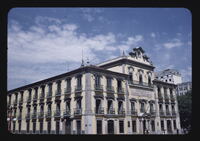 Departamento dos Correios e Telégrafos (Post Office and Telegraph Department Building) - General view Public Buildings - Rio de Janeiro Departamento dos Correios e Telégrafos (Post Office and Telegraph Department Building) General view from left Formerly the Imperial Palace of the city, seat of government in the time of the Monarchy (until 1889) . It was once the residence of the fugitive Portuguese Prince Regent Dom Joao, (later Joao VI of Portugal)
Departamento dos Correios e Telégrafos (Post Office and Telegraph Department Building) - General view Public Buildings - Rio de Janeiro Departamento dos Correios e Telégrafos (Post Office and Telegraph Department Building) General view from left Formerly the Imperial Palace of the city, seat of government in the time of the Monarchy (until 1889) . It was once the residence of the fugitive Portuguese Prince Regent Dom Joao, (later Joao VI of Portugal) -
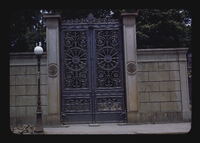 The Catete Palace - Bronze doors of garden entrance Public Buildings - Rio de Janeiro The Catete Palace Bronze doors of garden entrance
The Catete Palace - Bronze doors of garden entrance Public Buildings - Rio de Janeiro The Catete Palace Bronze doors of garden entrance -
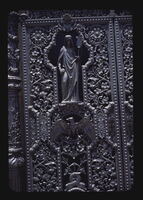 The Catete Palace - Bronze door Public Buildings - Rio de Janeiro The Catete Palace Bronze door: right side Sculpture
The Catete Palace - Bronze door Public Buildings - Rio de Janeiro The Catete Palace Bronze door: right side Sculpture -
 The Catete Palace - Bronze door Public Buildings - Rio de Janeiro The Catete Palace Bronze door: left side Sculpture
The Catete Palace - Bronze door Public Buildings - Rio de Janeiro The Catete Palace Bronze door: left side Sculpture -
 The Catete Palace - Bronze sculptured doors Public Buildings - Rio de Janeiro The Catete Palace Bronze sculptured doors
The Catete Palace - Bronze sculptured doors Public Buildings - Rio de Janeiro The Catete Palace Bronze sculptured doors -
 The Catete Palace - Main facade Central section Doorway Public Buildings - Rio de Janeiro The Catete Palace Main facade Central section Doorway
The Catete Palace - Main facade Central section Doorway Public Buildings - Rio de Janeiro The Catete Palace Main facade Central section Doorway -
 The Catete Palace - General view Public Buildings - Rio de Janeiro The Catete Palace General view
The Catete Palace - General view Public Buildings - Rio de Janeiro The Catete Palace General view -
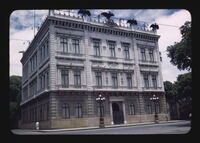 The Catete Palace - General view Public Buildings - Rio de Janeiro The Catete Palace Page 244 General view Constructed in 1862. Antonio Clemente Pinto, Baron of Nova Friburgo, bequeathed it to his son the Viscount of Sao Clemente, who enlarged the original structure. Later it was transferred to Francisco de Paula Mayrinch, who in turn ceded it to the Bank of Brazil. In 1896 it was sold by the Bank to the Government. The palace is now the seat of the Executive branch of the government and is used for Cabinet meetings and official receptions. On February 24, 1897, the palace was inaugurated as Brazil's capital building.The exterior of the first story is of local granite and the two upper floors are of pink marble and Lioz stone. The main door is bronze. A marble stairway, branching in both directions, leads to the upper floors.
The Catete Palace - General view Public Buildings - Rio de Janeiro The Catete Palace Page 244 General view Constructed in 1862. Antonio Clemente Pinto, Baron of Nova Friburgo, bequeathed it to his son the Viscount of Sao Clemente, who enlarged the original structure. Later it was transferred to Francisco de Paula Mayrinch, who in turn ceded it to the Bank of Brazil. In 1896 it was sold by the Bank to the Government. The palace is now the seat of the Executive branch of the government and is used for Cabinet meetings and official receptions. On February 24, 1897, the palace was inaugurated as Brazil's capital building.The exterior of the first story is of local granite and the two upper floors are of pink marble and Lioz stone. The main door is bronze. A marble stairway, branching in both directions, leads to the upper floors. -
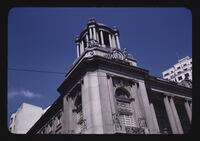 Prefeitura Municipal (City Hall) - Tower Public Buildings - Rio de Janeiro Prefeitura Municipal (City Hall) Tower
Prefeitura Municipal (City Hall) - Tower Public Buildings - Rio de Janeiro Prefeitura Municipal (City Hall) Tower -
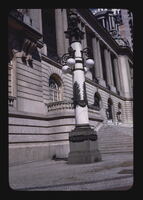 Prefeitura Municipal (City Hall) - Main facade Central section: Corner view Public Buildings - Rio de Janeiro Prefeitura Municipal (City Hall) Main facade Central section Corner view
Prefeitura Municipal (City Hall) - Main facade Central section: Corner view Public Buildings - Rio de Janeiro Prefeitura Municipal (City Hall) Main facade Central section Corner view -
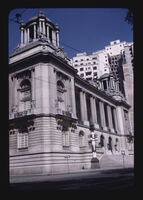 Prefeitura Municipal (City Hall) - General view Public Buildings - Rio de Janeiro Prefeitura Municipal (City Hall) General view Construction dates from the time of the Second Empire. Around 1940 it was remodeled and enlarged to centralize and accommodate the many city government offices
Prefeitura Municipal (City Hall) - General view Public Buildings - Rio de Janeiro Prefeitura Municipal (City Hall) General view Construction dates from the time of the Second Empire. Around 1940 it was remodeled and enlarged to centralize and accommodate the many city government offices -
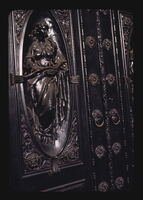 National Public Library - Main entrance Left door Public Buildings - Rio de Janeiro National Public Library Main entrance Left door: relief sculpture
National Public Library - Main entrance Left door Public Buildings - Rio de Janeiro National Public Library Main entrance Left door: relief sculpture -
 National Public Library - Main entrance Right door: relief sculpture Public Buildings - Rio de Janeiro National Public Library Main entrance Right door: relief sculpture
National Public Library - Main entrance Right door: relief sculpture Public Buildings - Rio de Janeiro National Public Library Main entrance Right door: relief sculpture -
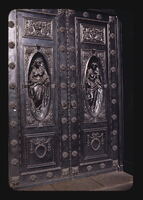 National Public Library - Main entrance Doors Public Buildings - Rio de Janeiro National Public Library Main entrance Doors
National Public Library - Main entrance Doors Public Buildings - Rio de Janeiro National Public Library Main entrance Doors -
 National Public Library - Main facade: Upper section General view Public Buildings - Rio de Janeiro National Public Library Main facade Upper section General view
National Public Library - Main facade: Upper section General view Public Buildings - Rio de Janeiro National Public Library Main facade Upper section General view -
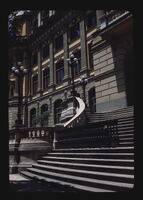 National Public Library - Main facade: General view of left section Stairway Public Buildings - Rio de Janeiro National Public Library Main facade General view of left section Stairway
National Public Library - Main facade: General view of left section Stairway Public Buildings - Rio de Janeiro National Public Library Main facade General view of left section Stairway -
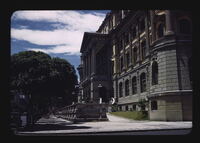 National Public Library - General view Public Buildings - Rio de Janeiro National Public Library General view Founded by Dorn Joao VI in 1810 with books brought from Lisbon, the library was installed in its present building in 1910, just one century later.
National Public Library - General view Public Buildings - Rio de Janeiro National Public Library General view Founded by Dorn Joao VI in 1810 with books brought from Lisbon, the library was installed in its present building in 1910, just one century later. -
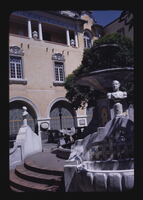 Museu Historico Nacional - Patio Fountain Public Buildings - Rio de Janeiro Museu Histórico Nacional Pátio Fountain
Museu Historico Nacional - Patio Fountain Public Buildings - Rio de Janeiro Museu Histórico Nacional Pátio Fountain -
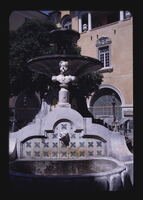 Museu Historico Nacional - Patio Fountain Public Buildings - Rio de Janeiro Museu Histórico Nacional Pátio Fountain
Museu Historico Nacional - Patio Fountain Public Buildings - Rio de Janeiro Museu Histórico Nacional Pátio Fountain -
 Museu Historico Nacional - Patio Public Buildings Rio de Janeiro Museu Histórico Nacional Pátio
Museu Historico Nacional - Patio Public Buildings Rio de Janeiro Museu Histórico Nacional Pátio -
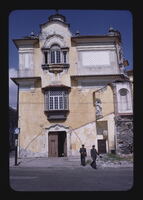 Museu Historico Nacional - Side wall Niche and sculpture Public Buildings Rio de Janeiro Museu Histórico Nacional Side wall Niche and sculpture
Museu Historico Nacional - Side wall Niche and sculpture Public Buildings Rio de Janeiro Museu Histórico Nacional Side wall Niche and sculpture -
 Museu Historico Nacional Section - main facade Public Buildings Rio de Janeiro Museu Histórico Nacional Section of main facade
Museu Historico Nacional Section - main facade Public Buildings Rio de Janeiro Museu Histórico Nacional Section of main facade -
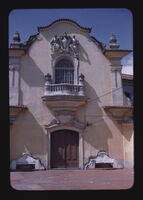 Museu Historico Nacional Section - main facade Public Buildings Rio de Janeiro Museu Histórico Nacional Section of main facade
Museu Historico Nacional Section - main facade Public Buildings Rio de Janeiro Museu Histórico Nacional Section of main facade -
 Museu Historico Nacional - Side elevation Public Buildings Rio de Janeiro Museu Histórico Nacional Side elevation
Museu Historico Nacional - Side elevation Public Buildings Rio de Janeiro Museu Histórico Nacional Side elevation -
 Museu Historico Nacional - Side elevation Public Buildings Rio de Janeiro Museu Histórico Nacional Side elevation
Museu Historico Nacional - Side elevation Public Buildings Rio de Janeiro Museu Histórico Nacional Side elevation -
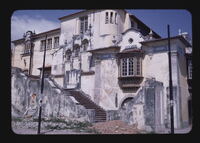 Museu Historico Nacional - Side elevation Public Buildings Rio de Janeiro Museu Histórico Nacional Side elevation The first section of the immense colonial structure in which the Historical Museum is now housed was erected in 1767 as a military barracks on land that then jutted into the harbor. The second and third sections were built in 1822 and 1835 respectively. The building is of strong simple design, enclosing a large patio. It is notable for its ironwork, stucco ornamentation, carved window frames and decorated tiles. In 1922 it was reconstructed to serve as the Museum, which was created by Presidential decree of August 2, 1922 and inaugurated on October 12, 1922. The same building also houses the Military and Naval Museums
Museu Historico Nacional - Side elevation Public Buildings Rio de Janeiro Museu Histórico Nacional Side elevation The first section of the immense colonial structure in which the Historical Museum is now housed was erected in 1767 as a military barracks on land that then jutted into the harbor. The second and third sections were built in 1822 and 1835 respectively. The building is of strong simple design, enclosing a large patio. It is notable for its ironwork, stucco ornamentation, carved window frames and decorated tiles. In 1922 it was reconstructed to serve as the Museum, which was created by Presidential decree of August 2, 1922 and inaugurated on October 12, 1922. The same building also houses the Military and Naval Museums -
 The Guanabara Palace - Rear of building facing the gardens Public Buildings Rio de Janeiro The Guanabara Palace Rear of building facing the gardens
The Guanabara Palace - Rear of building facing the gardens Public Buildings Rio de Janeiro The Guanabara Palace Rear of building facing the gardens -
 The Guanabara Palace - Main stairway and entrance Public Buildings Rio de Janeiro The Guanabara Palace Main stairway and entrance
The Guanabara Palace - Main stairway and entrance Public Buildings Rio de Janeiro The Guanabara Palace Main stairway and entrance -
 Emilio Goeldi Museum of Para - Miracanguera - Body of a Miracanguera clay effigy vessel Side view Indian Pottery - Amazon.Area Emilio Goeldi Museum of Para Miracanguera Body of a Miracanguera clay effigy vessel Side view (B-3 73)
Emilio Goeldi Museum of Para - Miracanguera - Body of a Miracanguera clay effigy vessel Side view Indian Pottery - Amazon.Area Emilio Goeldi Museum of Para Miracanguera Body of a Miracanguera clay effigy vessel Side view (B-3 73) -
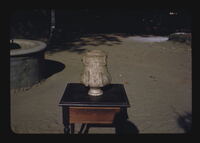 Emilio Goeldi Museum of Para - Miracanguera - Body of a Miracanguera clay effigy vessel Front view Indian Pottery - Amazon Area Emilio Goeldi Museum of Para Miracanguera Body of a Miracanguera clay effigy vessel Front view Note stylization of arms and legs
Emilio Goeldi Museum of Para - Miracanguera - Body of a Miracanguera clay effigy vessel Front view Indian Pottery - Amazon Area Emilio Goeldi Museum of Para Miracanguera Body of a Miracanguera clay effigy vessel Front view Note stylization of arms and legs -
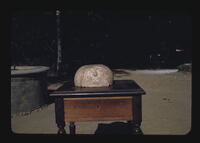 Emilio Goeldi Museum of Para - Miracanguera Site Indian Pottery - Amazon Area Emilio Goeldi Museum of Para Miracanguera Site of this culture no longer visible It is believed to be located on a tributary of the Amazon "Pumpkin head" lid from a pottery jar
Emilio Goeldi Museum of Para - Miracanguera Site Indian Pottery - Amazon Area Emilio Goeldi Museum of Para Miracanguera Site of this culture no longer visible It is believed to be located on a tributary of the Amazon "Pumpkin head" lid from a pottery jar -
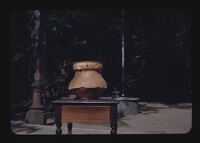 Emilio Goeldi Museum of Para Rio - Cunani - Funeral urn Effigy figure Indian Pottery - Amazon Area Emilio Goeldi Museum of Para Rio Cunani Funeral urn Effigy figure
Emilio Goeldi Museum of Para Rio - Cunani - Funeral urn Effigy figure Indian Pottery - Amazon Area Emilio Goeldi Museum of Para Rio Cunani Funeral urn Effigy figure -
 Emilio Goeldi Museum of Para Rio - Cunani - Funeral urn Side view Indian Pottery - Amazon Area Emilio Goeldi Museum of Para Rio Cunani Funeral urn Side view (B-3 69)
Emilio Goeldi Museum of Para Rio - Cunani - Funeral urn Side view Indian Pottery - Amazon Area Emilio Goeldi Museum of Para Rio Cunani Funeral urn Side view (B-3 69) -
 Emilio Goeldi Museum of Para Rio - Cunani - Funeral urn from Rio Cunani Indian Pottery - Amazon Area Emilio Goeldi Museum of Para Rio Cunani Funeral urn from Rio Cunani (situated in northern Brazil, this river flows into the Atlantic) Characteristic of the effigy urns of this culture are the painted (red on yellow ware) "stairway design" on the front of the figure; the placing of the features of the face on the neck of the urn; and the truncated cone shape of the lower section
Emilio Goeldi Museum of Para Rio - Cunani - Funeral urn from Rio Cunani Indian Pottery - Amazon Area Emilio Goeldi Museum of Para Rio Cunani Funeral urn from Rio Cunani (situated in northern Brazil, this river flows into the Atlantic) Characteristic of the effigy urns of this culture are the painted (red on yellow ware) "stairway design" on the front of the figure; the placing of the features of the face on the neck of the urn; and the truncated cone shape of the lower section -
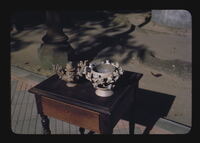 Emilio Goeldi Museum of Para - Tapajo culture - Tapajo ceremonial vessels Top view of vessels Indian Pottery - Amazon Area Emilio Goeldi Museum of Para Tapajo culture Tapajo ceremonial vessels Top view of vessels (B-3 67)
Emilio Goeldi Museum of Para - Tapajo culture - Tapajo ceremonial vessels Top view of vessels Indian Pottery - Amazon Area Emilio Goeldi Museum of Para Tapajo culture Tapajo ceremonial vessels Top view of vessels (B-3 67) -
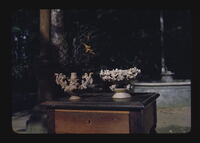 Emilio Goeldi Museum of Para - Tapajo culture - Tapajo ceremonial vessels Indian Pottery - Amazon Area Emilio Goeldi Museum of Para Tapajo culture Tapajo ceremonial vessels Modeled stylized decorations around edge of bowl represent fauna of the area Note the use of caryatid figures to support the bowl of the vessel at left
Emilio Goeldi Museum of Para - Tapajo culture - Tapajo ceremonial vessels Indian Pottery - Amazon Area Emilio Goeldi Museum of Para Tapajo culture Tapajo ceremonial vessels Modeled stylized decorations around edge of bowl represent fauna of the area Note the use of caryatid figures to support the bowl of the vessel at left -
 Emilio Goeldi Museum of Para - Closer view of vessel Indian Pottery - Amazon Area Emilio Goeldi Museum of Para Closer view of vessel (B-3 65)
Emilio Goeldi Museum of Para - Closer view of vessel Indian Pottery - Amazon Area Emilio Goeldi Museum of Para Closer view of vessel (B-3 65) -
 Emilio Goeldi Museum of Para - Pottery vessel Indian Pottery - Amazon Area Emilio Goeldi Museum of Para Pottery vessel in the form of an animal figure which represents the South American jaguar onca Side view
Emilio Goeldi Museum of Para - Pottery vessel Indian Pottery - Amazon Area Emilio Goeldi Museum of Para Pottery vessel in the form of an animal figure which represents the South American jaguar onca Side view -
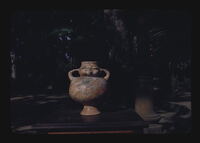 Emilio Goeldi Museum of Para - Closer view of effigy urn Indian Pottery - Amazon Area Emilio Goeldi Museum of Para Closer view of effigy urn (B-3 63)
Emilio Goeldi Museum of Para - Closer view of effigy urn Indian Pottery - Amazon Area Emilio Goeldi Museum of Para Closer view of effigy urn (B-3 63) -
 Emilio Goeldi Museum of Para - Tapajo culture - Site uncertain Tapajo painted urn Indian Pottery - Amazon Area Emilio Goeldi Museum of Para Tapajo culture Site uncertain Tapajo painted urn in the form of an effigy figure Stylized treatment of rounded face with puffed-out cheeks, rounded body and characteristic raised arms
Emilio Goeldi Museum of Para - Tapajo culture - Site uncertain Tapajo painted urn Indian Pottery - Amazon Area Emilio Goeldi Museum of Para Tapajo culture Site uncertain Tapajo painted urn in the form of an effigy figure Stylized treatment of rounded face with puffed-out cheeks, rounded body and characteristic raised arms